Impact of Land Use Change on the Spatial and Temporal Evolution of Ecosystem Service Values in South China Karst Areas
Abstract
1. Introduction
2. Materials and Methods
2.1. Overview of the Study Area
2.2. Data Sources
2.3. Research Methods
2.3.1. CA-Markov Model
2.3.2. Land Use Dynamic Changes
2.3.3. Calculation of ESVs
2.3.4. Distribution of Spatial and Temporal Variation in ESVs
2.3.5. Sensitivity Analysis
2.3.6. Statistical Analysis
3. Results
3.1. Analysis of Land Use Change
3.1.1. Land Use Pattern Change
3.1.2. Land Use Transfer Distribution
3.2. Changes in ESVs
3.2.1. Trends in Temporal Change
3.2.2. Trends in Temporal Change
3.3. Sensitivity Analysis
4. Discussion
4.1. Land Use Change Influencing Factors
4.2. Spatial and Temporal Evolution of ESVs
4.2.1. Temporal Trends
4.2.2. Spatial Distribution Patterns
4.3. Future Responses to Rocky Desertification Control Based on Ecosystem Services Assessment
5. Conclusions
Author Contributions
Funding
Data Availability Statement
Acknowledgments
Conflicts of Interest
References
- Williams, S.E.; Hobday, A.J.; Falconi, L.; Hero, J.; Holbrook, N.J.; Capon, S.; Bond, N.R.; Ling, S.D.; Hughes, L. Research priorities for natural ecosystems in a changing global climate. Glob. Chang. Biol. 2019, 26, 410–416. [Google Scholar]
- Li, D.L.; Wu, S.Y.; Liu, L.B.; Zhang, Y.T.; Li, S.C. Vulnerability of the global terrestrial ecosystems to climate change. Glob. Chang. Biol. 2018, 24, 4095–4106. [Google Scholar] [CrossRef]
- Ogle, S.M.; Domke, G.; Kurz, W.A.; Rocha, M.T.; Huffman, T.; Swan, A.; Smith, J.E.; Woodall, C.; Krug, T. Delineating managed land for reporting national greenhouse gas emissions and removals to the United Nations framework convention on climate change. Carbon Balance Manag. 2018, 13, 9. [Google Scholar] [CrossRef]
- Peng, J.; Tian, L.; Zhang, Z.; Zhao, Y.; Green, S.M.; Quine, T.A.; Liu, H.; Meersmans, J. Distinguishing the impacts of land use and climate change on ecosystem services in a karst landscape in China. Ecosyst. Serv. 2020, 46, 101199. [Google Scholar] [CrossRef]
- Palmer, M.; Ruhi, A. Linkages between flow regime, biota, and ecosystem processes: Implications for river restoration. Science 2019, 365, eaaw2087. [Google Scholar] [CrossRef] [PubMed]
- Holdren, J.P.; Ehrlich, P.R. Human population and the global environment. Am. Sci. 1974, 62, 282–292. [Google Scholar]
- Millennium Ecosystem Assesment(MEA). Ecosystems and Human Well-Being: The Assessment Series (Four Volumes and Summary); Island Press: Washington, DC, USA, 2005; Volume 10. [Google Scholar]
- Costanza, R.; Arge, R.; Groot, R.D.; Farber, S.; Grasso, M.; Hannon, B.; Limburg, K.; Naeem, S.; Paruelo, J.; Raskin, R.G.; et al. The value of the world’s ecosystem services and natural capital. Nature 1997, 387, 253–260. [Google Scholar] [CrossRef]
- Sannigrahi, S.; Bhatt, S.; Rahmat, S.; Paul, S.K.; Sen, S. Estimating global ecosystem service values and its response to land surface dynamics during 1995–2015. J. Environ. Manag. 2018, 223, 115–131. [Google Scholar] [CrossRef] [PubMed]
- Aziz, T. Changes in land use and ecosystem services values in Pakistan, 1950–2050. Environ. Dev. 2021, 37, 100576. [Google Scholar] [CrossRef]
- Shrestha, B.; Ye, Q.; Khadka, N. Assessment of ecosystem services value based on land use and land cover changes in the transboundary Karnali River Basin, Central Himalayas. Sustainability 2019, 11, 3183. [Google Scholar] [CrossRef]
- Campbell, E.; Marks, R.; Conn, C. Spatial modeling of the biophysical and economic values of ecosystem services in Maryland, USA. Ecosyst. Serv. 2020, 43, 101093. [Google Scholar] [CrossRef]
- Bryan, B.A.; Ye, Y.; Zhang, J.; Connor, J.D. Land-use change impacts on ecosystem services value: Incorporating the scarcity effects of supply and demand dynamics. Ecosyst. Serv. 2018, 32, 144–157. [Google Scholar] [CrossRef]
- Hasan, S.S.; Zhen, L.; Miah, M.G.; Ahamed, T.; Samie, A. Impact of land use change on ecosystem services: A review. Environ. Dev. 2020, 34, 100527. [Google Scholar] [CrossRef]
- Song, X.P.; Hansen, M.C.; Stehman, S.V.; Potapov, P.V.; Tyukavina, A.; Vermote, E.F.; Townshend, J.R. Global land change from 1982 to 2016. Nature 2018, 560, 639–643. [Google Scholar] [CrossRef] [PubMed]
- Xie, G.D.; Lu, C.X.; Leng, Y.F.; Zheng, D.; Li, S.C. Ecological assets valuation of the Tibetan Plateau. J. Nat. Resour. 2003, 18, 189–196. [Google Scholar]
- Aznarez, C.; Jimeno-Sáez, P.; López-Ballesteros, A.; Pacheco, J.P.; Senent-Aparicio, J. Analysing the Impact of Climate Change on Hydrological Ecosystem Services in Laguna del Sauce (Uruguay) Using the SWAT Model and Remote Sensing Data. Remote Sens. 2021, 13, 2014. [Google Scholar] [CrossRef]
- Zhang, M.; Wang, K.; Liu, H.; Zhang, C.; Yue, Y.; Qi, X. Effect of ecological engineering projects on ecosystem services in a karst region: A case study of northwest Guangxi, China. J. Clean. Prod. 2018, 183, 831–842. [Google Scholar] [CrossRef]
- Shi, L.; Halik, U.; Mamat, Z.; Wei, Z.C. Spatio-temporal variation of ecosystem services value in the Northern Tianshan Mountain Economic zone from 1980 to 2030. PEERJ 2020, 8, e9582. [Google Scholar] [CrossRef]
- Wang, Q.; Cheng, L.; Zhang, L.; Liu, P.; Qin, S.; Liu, L.; Jing, Z. Quantifying the impacts of land-cover changes on global evapotranspiration based on the continuous remote sensing observations during 1982–2016. J. Hydrol. 2021, 598, 126231. [Google Scholar] [CrossRef]
- Purvis, A.; Newbold, T.; De Palma, A.; Contu, S.; Hill, S.L.; Sanchez-Ortiz, K.; Phillips, H.R.; Hudson, L.N.; Lysenko, I.; Börger, L.; et al. Modelling and Projecting the Response of Local Terrestrial Biodiversity Worldwide to Land Use and Related Pressures: The PREDICTS Project. Adv. Ecol. Res. 2018, 58, 201–241. [Google Scholar]
- Yan, R.; Zhang, X.; Yan, S.; Chen, H. Estimating soil erosion response to land use/cover change in a catchment of the Loess Plateau, China. Int. Soil Water Conserv. Res. 2018, 6, 13–22. [Google Scholar] [CrossRef]
- Quesada, B.; Arneth, A.; Robertson, E.; de Noblet-Ducoudré, N. Potential strong contribution of future anthropogenic land-use and land-cover change to the terrestrial carbon cycle. Environ. Res. Lett. 2018, 13, 064023. [Google Scholar] [CrossRef]
- Goldscheider, N.; Chen, Z.; Auler, A.S.; Bakalowicz, M.; Broda, S.; Drew, D.; Hartmann, J.; Jiang, G.; Moosdorf, N.; Stevanovic, Z.; et al. Global distribution of carbonate rocks and karst water resources. Hydrogeol. J. 2020, 28, 1661–1677. [Google Scholar] [CrossRef]
- Ford, D.C.; Willianms, P. Karst Hydrogeology and Geomorphology; Wiley: Chichester, UK, 2007. [Google Scholar]
- Xiong, K.N.; Chi, Y.K. The problems in southern china karst ecosystem in southern of China and its countermeasures. Ecol. Econ. 2015, 31, 23–30. [Google Scholar]
- Pei, J.; Wang, L.; Huang, N.; Geng, J.; Cao, J.; Niu, Z. Analysis of Landsat-8 OLI Imagery for Estimating Exposed Bedrock Fractions in Typical Karst Regions of Southwest China Using a Karst Bare-Rock Index. Remote Sens. 2018, 10, 1321. [Google Scholar] [CrossRef]
- Xiong, K.N.; Li, J.; Long, M.Z. Features of soil and water loss and key issues in demonstration areas for combating karst rocky desertification. Acta Geogr. Sin. 2012, 67, 878–888. [Google Scholar]
- Zhang, S.H.; Xiong, K.N.; Qin, Y.; Min, X.Y.; Xiao, J. Evolution and determinants of ecosystem services: Insights from South China karst. Ecol. Indic. 2021, 133, 108437. [Google Scholar] [CrossRef]
- Xu, Q.Q.; Xiong, K.N.; Chi, Y.K. Effects of Intercropping on Fractal Dimension and Physicochemical Properties of Soil in Karst Areas. Forests 2021, 12, 1422. [Google Scholar] [CrossRef]
- Zhang, J.; Zhou, X.; Jiang, X.; Yang, J.X.; Luo, X. Spatial and temporal variability characteristics of water use efficiency in different landform regions and vegetation types of Guizhou Plateau, China. Mt. Res. 2019, 37, 173–185. [Google Scholar]
- Trac, C.J.; Harrell, S.; Hinckley, T.M.; Henck, A.C. Reforestation programs in Southwest China: Reported success, observed failure, and the reasons why? J. Mt. Sci. 2007, 4, 275–292. [Google Scholar] [CrossRef]
- Liu, J.Y.; Kuang, W.H.; Zhang, Z.X.; Xu, X.; Qin, Y.; Ning, J.; Zhou, W.; Zhang, S.; Li, R.; Yan, C.; et al. Spatiotemporal characteristics, patterns and causes of land use changes in China since the late 1980s. Acta Geogr. Sin. 2014, 69, 3–14. [Google Scholar] [CrossRef]
- Fu, F.; Deng, S.; Wu, D.; Liu, W.W.; Bai, Z.H. Research on the spatiotemporal evolution of land use landscape pattern in a county area based on CA-Markov model. Sustain. Cities Soc. 2022, 80, 103760. [Google Scholar] [CrossRef]
- Chu, L.; Zhang, X.R.; Wang, T.W.; Li, Z.; Cai, C. Spatial-temporal evolution and prediction of urban landscape pattern and habitat quality based on CA-Markov and InVEST model. Chin. J. Appl. Ecol. 2018, 29, 4106–4118. [Google Scholar]
- Chen, W.; Zhang, X.; Huang, Y. Spatial and temporal changes in ecosystem service values in karst areas in southwestern China based on land use changes. Environ. Sci. Pollut. Res. 2021, 28, 1–15. [Google Scholar]
- Heidarlou, H.B.; Shafiei, A.B.; Erfanian, M.; Tayyebi, A.; Alijanpour, A. Underlying driving forces of forest cover changes due to the implementation of preservation policies in Iranian northern Zagros forests. Int. For. Rev. 2020, 22, 241–256. [Google Scholar] [CrossRef]
- Jiang, Z.; Sun, X.; Liu, F.; Shan, R.; Zhang, W. Spatio-temporal variation of land use and ecosystem service values and their impact factors in an urbanized agricultural basin since the reform andopening of China. Environ. Monit. Assess. 2019, 191, 739. [Google Scholar] [CrossRef]
- Xie, G.; Zhang, C.; Zhen, L.; Zhang, L. Dynamic changes in the value of China’s ecosystem services. Ecosyst. Serv. 2017, 26, 146–154. [Google Scholar] [CrossRef]
- Xu, X.B.; Chen, S.; Yang, G.S. Spatial and temporal change in ecological assets in the Yangtze River Delta of China 1995–2007. Acta Ecol. Sin. 2012, 32, 7667–7675. [Google Scholar]
- Wang, Z.; Cao, J.; Zhu, C.; Yang, H. The Impact of Land Use Change on Ecosystem Service Value in the Upstream of Xiong’an New Area. Sustainability 2020, 12, 5707. [Google Scholar] [CrossRef]
- Song, W.; Deng, X. Land-use/land-cover change and ecosystem service provision in China. Sci. Total Environ. 2017, 576, 705–719. [Google Scholar] [CrossRef]
- Hanson, A.J.; Bass, S.; Bouzaher, A.; Samdani, G.M. Pakistan’s National Conservation Strategy: Renewing Commitment to Action; MELGRD (NCS Unit): Islamabad, Pakistan, 2000. [Google Scholar]
- Yuan, K.; Li, F.; Yang, H.; Wang, Y. The Influence of Land Use Change on Ecosystem Service Value in Shangzhou District. Int. J. Environ. Res. Public Health 2019, 16, 1321. [Google Scholar] [CrossRef]
- Shen, H.Z.; Tao, S.; Chen, Y.L.; Ciais, P.; Güneralp, B.; Ru, M.; Zhong, Q.; Yun, X.; Zhu, X.; Huang, T.; et al. Urbanization-induced population migration has reduced ambient PM2.5 concentrations in China. Sci. Adv. 2017, 3, e1700300. [Google Scholar] [CrossRef] [PubMed]
- Fang, Z.; Ding, T.H.; Chen, J.Y.; Xue, S.; Zhou, Q.; Wang, Y.; Wang, Y.; Huang, Z.; Yang, S. Impacts of land use/land cover changes on ecosystem services in ecologically fragile regions. Sci. Total Environ. 2022, 831, 154967. [Google Scholar] [CrossRef] [PubMed]
- Bai, Y.; Ochuodho, T.O.; Yang, J. Impact of land use and climate change on water-related ecosystem services in Kentucky, USA. Ecol. Indic. 2019, 102, 51–64. [Google Scholar] [CrossRef]
- Zhuo, C.F.; Deng, F. How does China’s Western Development Strategy affect regional green economic efficiency? Sci. Total Environ. 2020, 707, 135939. [Google Scholar] [CrossRef] [PubMed]
- Wu, C.Y.; Chen, B.W.; Huang, X.J.; Wei, Y.H.D. Effect of land-use change and optimization on the ecosystem service values of Jiangsu province, China. Ecol. Indic. 2020, 117, 106507. [Google Scholar] [CrossRef]
- Li, Y.; Yang, R.B.; Bi, J.P.; Zhou, N.D.; Yi, M.; Hu, W.M. Analysis on the Pattern of Ecological Capital in CZT Region. Econ. Geogr. 2015, 35, 184–188+208. [Google Scholar]
- Bai, X.Y.; Wang, S.J.; Xiong, K.N. Assessing spatial-temporal evolution processes of karst rocky desertification land: Indications for restoration strategies. Land Degrad. Dev. 2013, 24, 47–56. [Google Scholar] [CrossRef]
- Feng, X.; Fu, B.; Lu, N.; Zeng, Y.; Wu, B. How ecological restoration alters ecosystem services: An analysis of vegetation carbon sequestration in the China’s Loess Plateau. Sci. Rep. 2013, 3, 2846. [Google Scholar] [CrossRef]
- Li, M.H.; Wang, X.Y.; Chen, J.C. Assessment of grassland ecosystem services and analysis on its driving factors: A case study in hulunbuir grassland. Front. Ecol. Evol. 2022, 10, 841943. [Google Scholar] [CrossRef]
- Li, L.; Fan, Z.; Xiong, K.N.; Shen, H.; Guo, Q.; Dan, W.; Li, R. Current situation and prospects of the studies of ecological industries and ecological products in eco-fragile areas. Environ. Res. 2021, 201, 111613. [Google Scholar] [CrossRef] [PubMed]
- Wang, Y.M.; Zhang, Z.X.; Chen, X. Spatiotemporal change in ecosystem service value in response to land use change in Guizhou Province, southwest China. Ecol. Indic. 2022, 144, 109514. [Google Scholar] [CrossRef]
- Han, H.Q.; Su, Z.H. Research progress and prospects of karst ecosystem services. Carsolog. Sin. 2017, 36, 352–358. [Google Scholar]
- He, C.; Xiong, K.N.; Chi, Y.K.; Song, S.Z.; Fang, J.Z.; He, S.Y. Effects of landscape type change on spatial and temporal evolution of ecological assets in a karst Plateau-Mountain area. Int. J. Environ. Res. Public Health 2022, 19, 4477. [Google Scholar] [CrossRef]
- Ma, G.X.; Zhou, Z.F.; Zhu, C.L.; Wu, Y.; Dan, Y.S. Relationship between livelihood capital and livelihood strategy of farmers in rocky desertification area- a case of Guanling-Zhenfeng Huajiang rocky desertification comprehensive demonstration zone in Guizhou province. Bull. Soil Water Conserv. 2020, 40, 299–307. [Google Scholar]
- Cao, S.S.; Zhao, W.J.; Duan, F.Z. Coupling relation analysis between ecological value and economic poverty of contiguous destitute areas in Qinling-Dabashan region. Geogr. Res. 2015, 34, 1295–1309. [Google Scholar]
- Sun, X.; Yang, P.; Tao, Y.; Bian, H. Improving ecosystem services supply provides insights for sustainable landscape planning: A case study in Beijing, China. Sci. Total Environ. 2022, 802, 149849. [Google Scholar] [CrossRef]
- Liu, S.J.; Wang, Z.J.; Wu, W.; Yu, L.F. Effects of landscape pattern change on ecosystem services and its interactions in karst cities: A case study of Guiyang City in China. Ecol. Indic. 2023, 145, 109646. [Google Scholar] [CrossRef]
- Wei, S.; Pan, J.; Liu, X. Landscape ecological safety assessment and landscape pattern optimization in arid inland river basin: Take Ganzhou District as an example. Hum. Ecol. Risk Assess. 2018, 26, 782–806. [Google Scholar] [CrossRef]
- Jezeer, R.E.; Santos, M.J.; Verweij, P.A.; Boot, R.G.A.; Clough, Y. Benefits for multiple ecosystem services in Peruvian coffee agroforestry systems without reducing yield. Ecosyst. Serv. 2019, 40, 101033. [Google Scholar] [CrossRef]
- He, S.Y.; Xiong, K.N.; Song, S.Z.; Chi, Y.K.; Fang, J.Z.; He, C. Research Progress of Grassland Ecosystem Structure and Stability and Inspiration for Improving Its Service Capacity in the Karst Desertification Control. Plants 2023, 12, 770. [Google Scholar] [CrossRef] [PubMed]
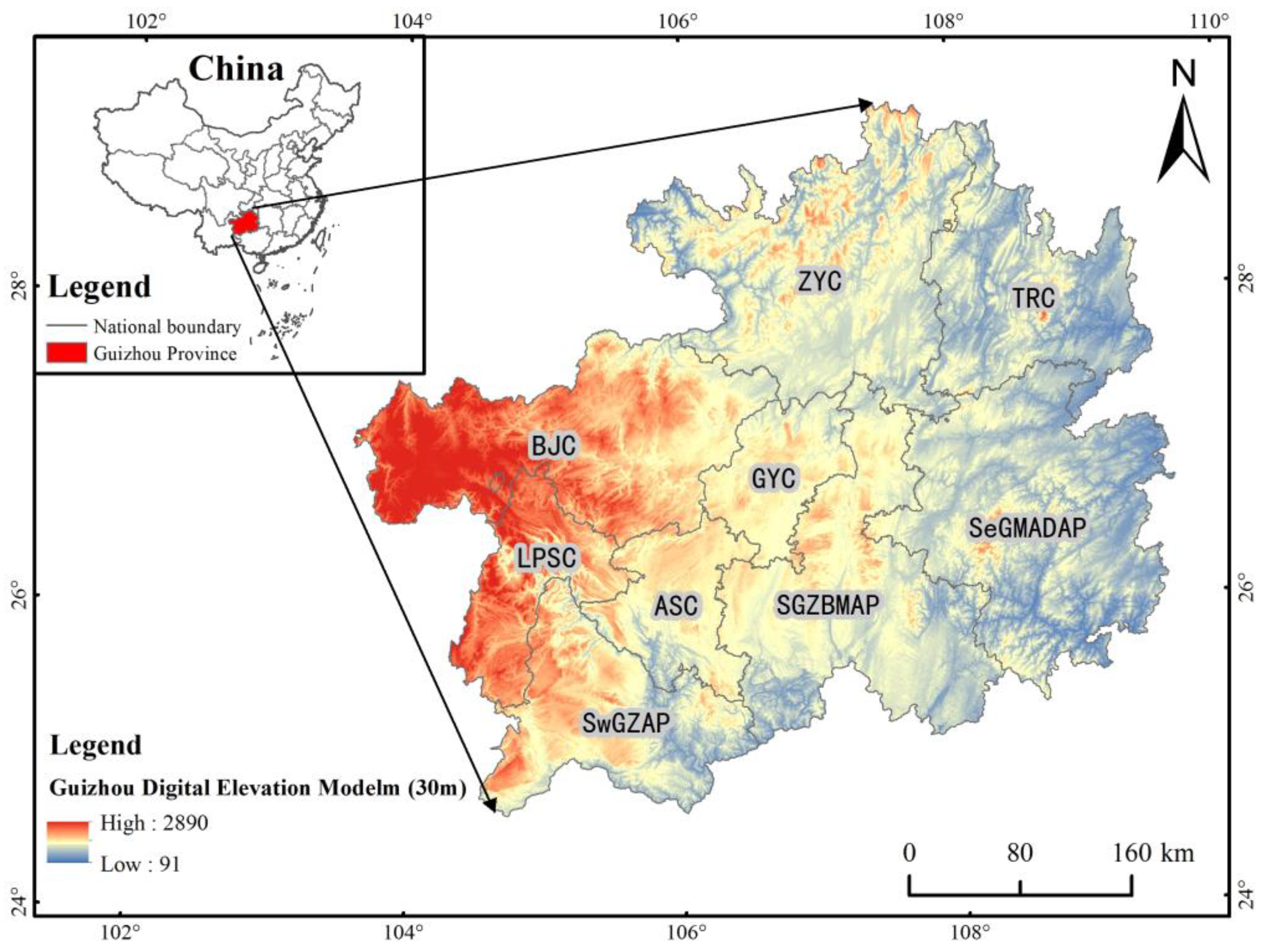


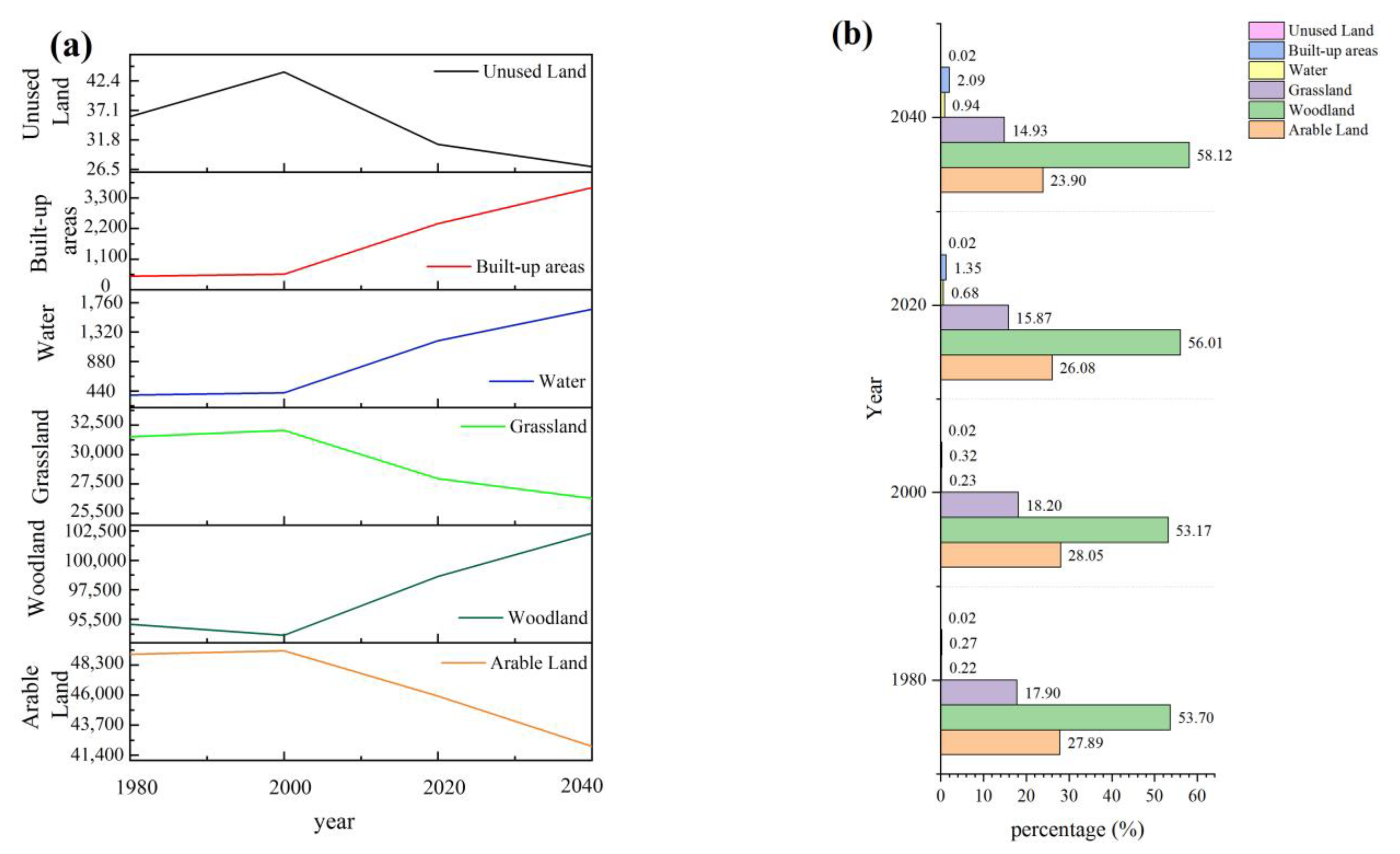

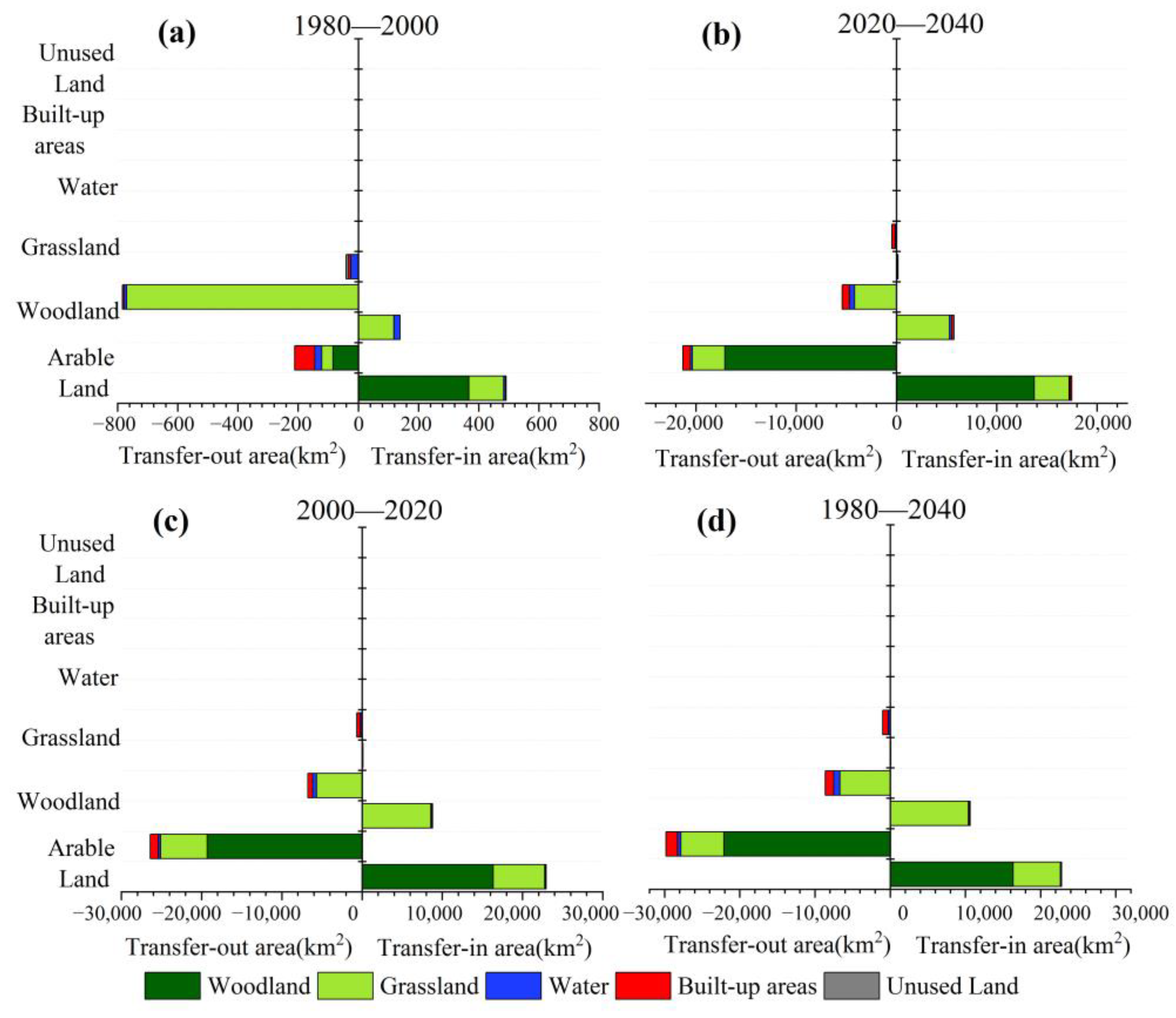
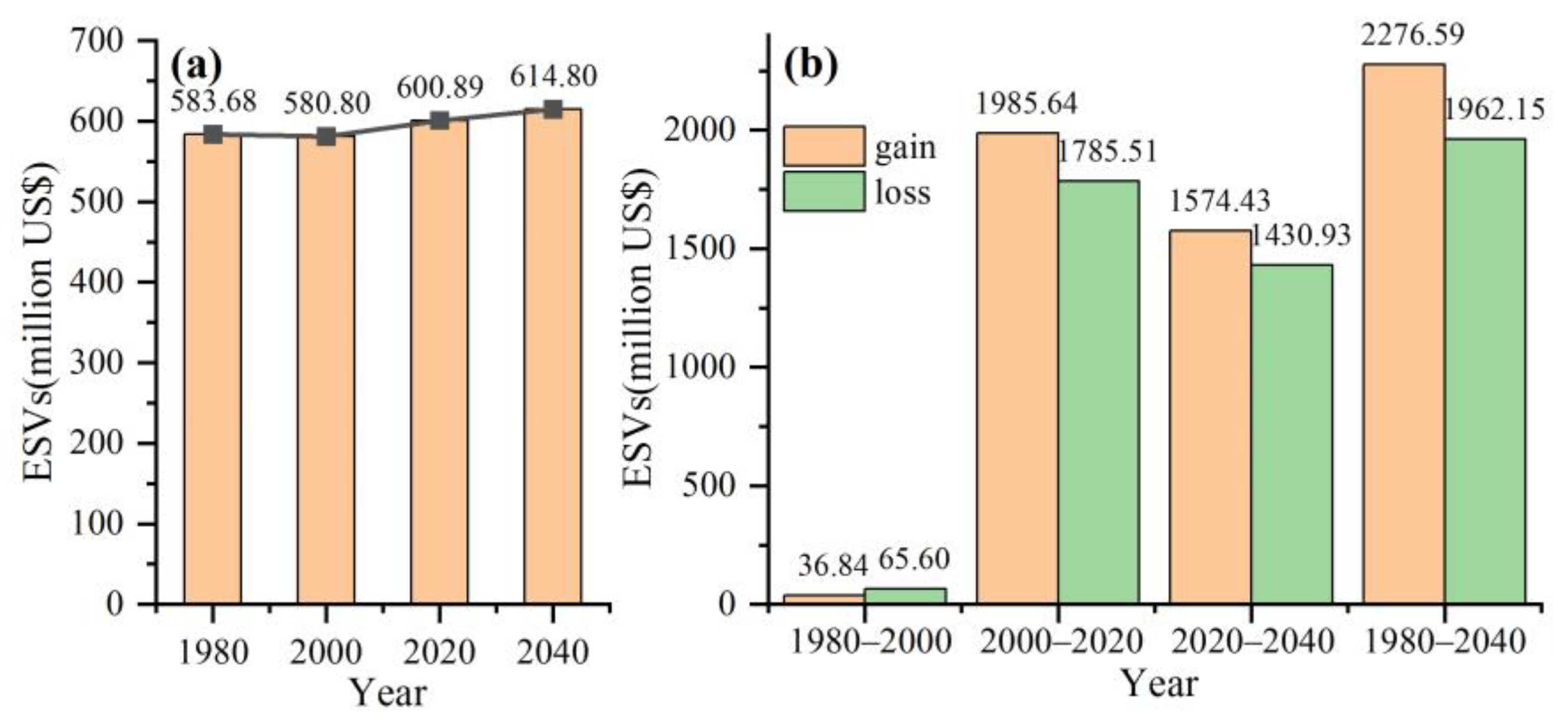
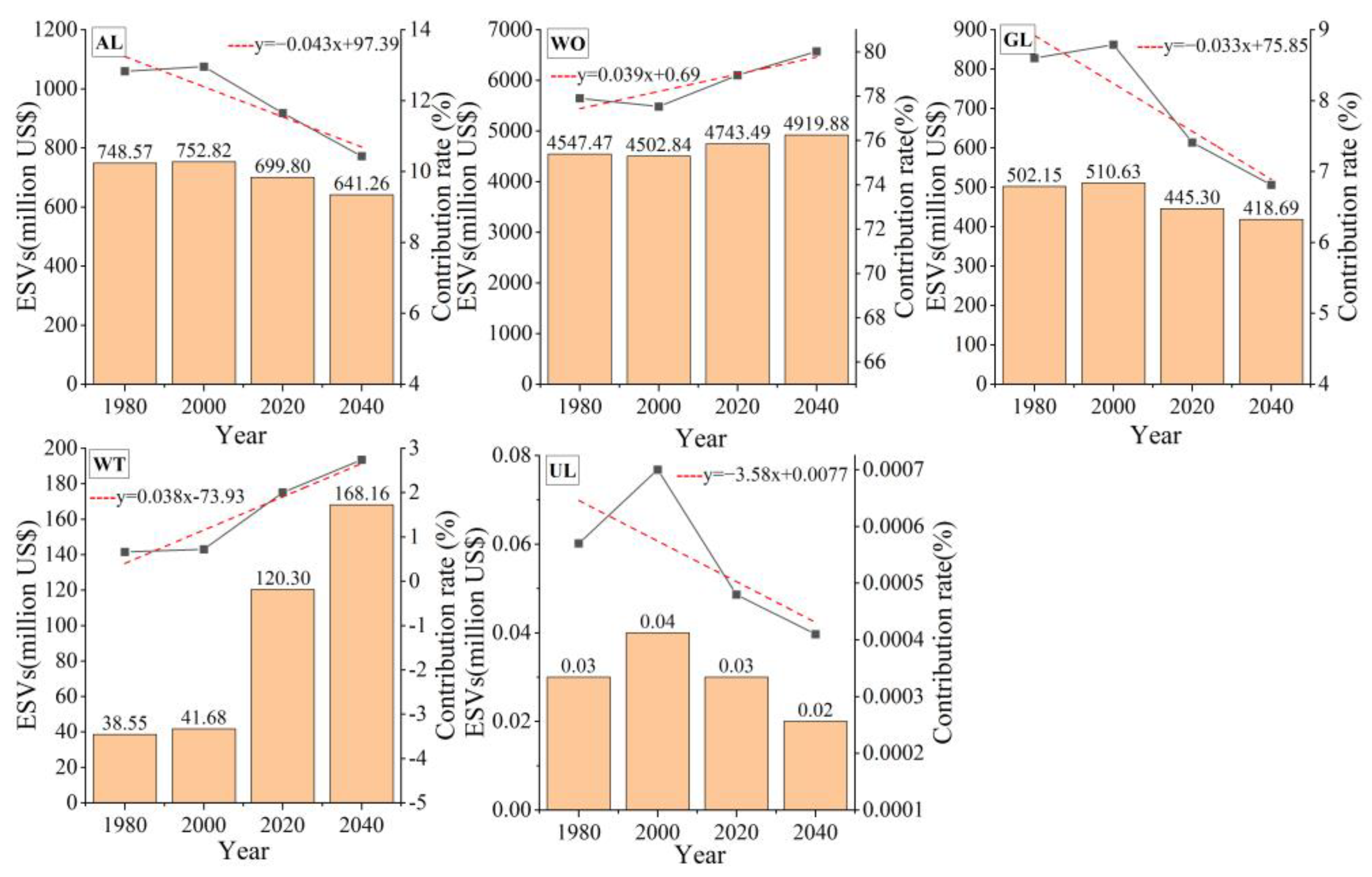
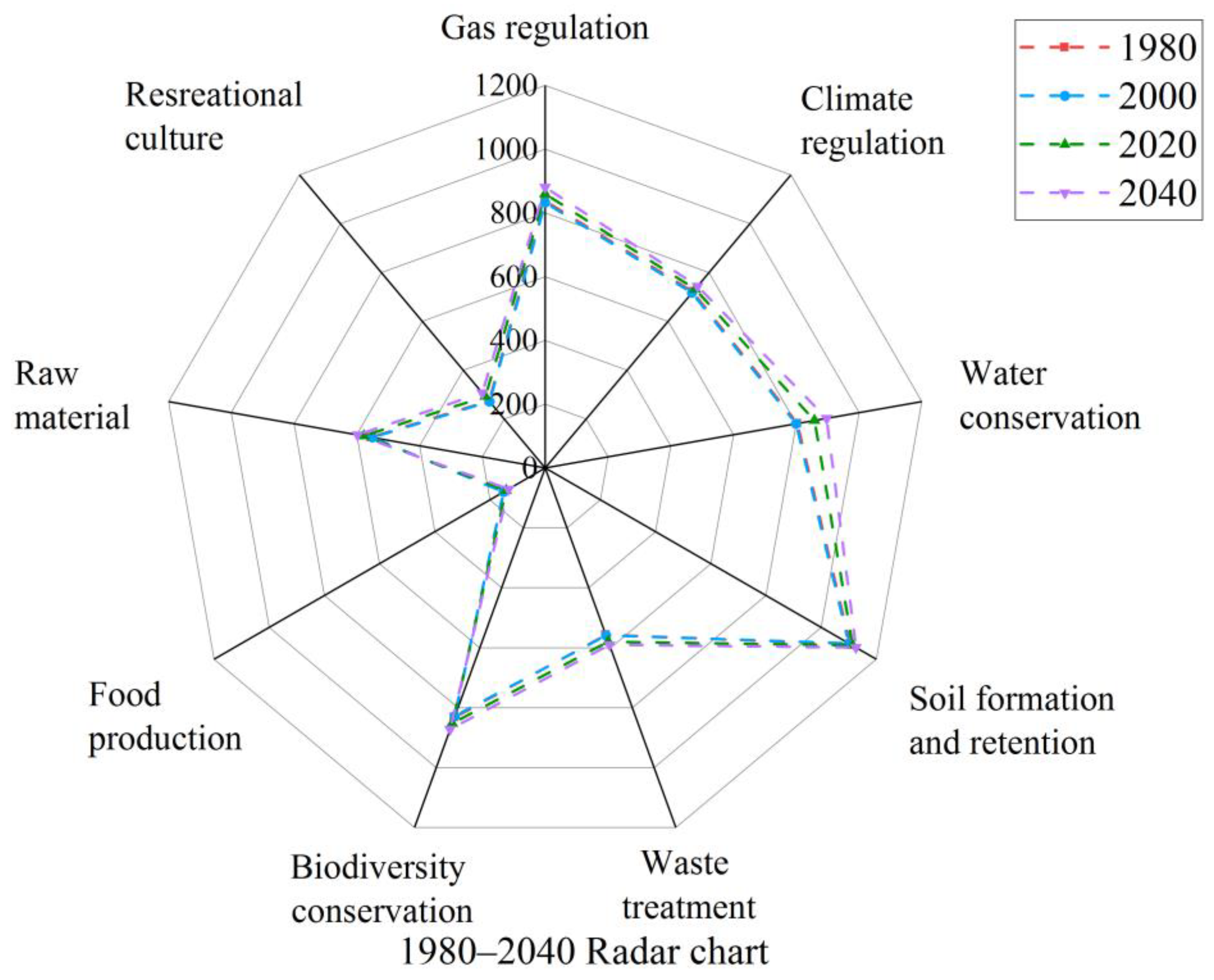

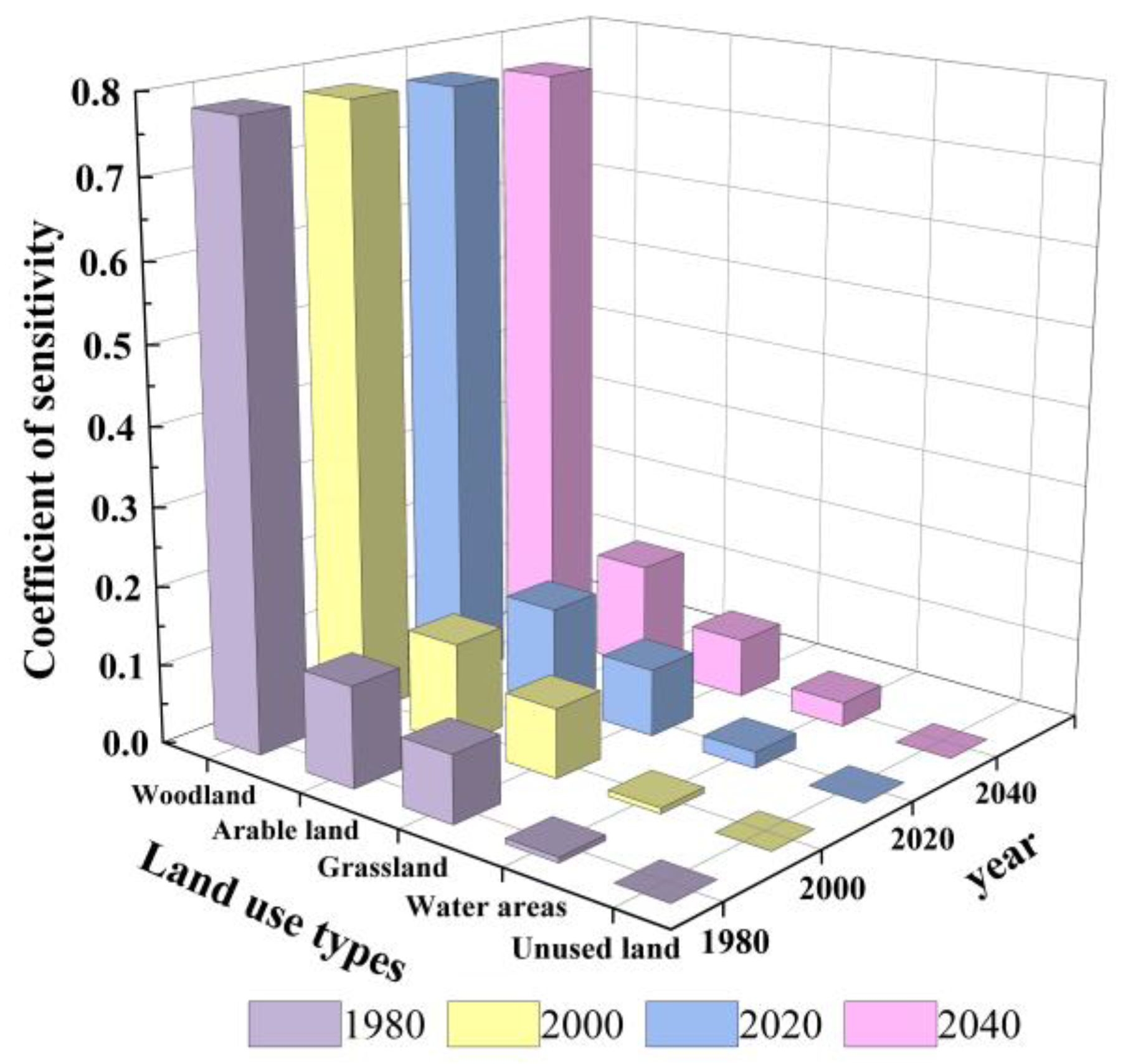
| ES Types | Arable Land | Woodland | Grassland | Water | Unused Land |
|---|---|---|---|---|---|
| Gas regulation | 110.05 | 770.33 | 176.07 | 0.00 | 0.00 |
| Climate regulation | 195.88 | 594.25 | 198.08 | 101.24 | 0.00 |
| Water conservation | 132.06 | 704.30 | 176.07 | 4485.50 | 6.60 |
| Soil formation and retention | 321.34 | 858.36 | 429.18 | 2.20 | 4.40 |
| Waste treatment | 364.13 | 288.32 | 288.32 | 4001.29 | 2.20 |
| Biodiversity conservation | 156.27 | 717.50 | 239.90 | 548.03 | 74.83 |
| Food production | 220.09 | 22.01 | 66.03 | 22.01 | 2.20 |
| Raw material | 22.01 | 572.24 | 11.00 | 2.20 | 0.00 |
| Recreational culture | 2.20 | 281.72 | 8.80 | 955.20 | 2.20 |
| Land Use Type | ||||||
|---|---|---|---|---|---|---|
| Time | Arable Land | Woodland | Grassland | Water | Built-Up Areas | Unused Land |
| 1980–2000 | 0.03 | −0.05 | 0.08 | 0.41 | 0.81 | 1.11 |
| 2000–2020 | −0.35 | 0.27 | −0.64 | 9.43 | 16.16 | −1.48 |
| 2020–2040 | −0.42 | 0.19 | −0.30 | 1.99 | 2.73 | −0.65 |
| 1980–2040 | −0.72 | 0.41 | −0.83 | 16.81 | 32.96 | −1.25 |
Disclaimer/Publisher’s Note: The statements, opinions and data contained in all publications are solely those of the individual author(s) and contributor(s) and not of MDPI and/or the editor(s). MDPI and/or the editor(s) disclaim responsibility for any injury to people or property resulting from any ideas, methods, instructions or products referred to in the content. |
© 2023 by the authors. Licensee MDPI, Basel, Switzerland. This article is an open access article distributed under the terms and conditions of the Creative Commons Attribution (CC BY) license (https://creativecommons.org/licenses/by/4.0/).
Share and Cite
Chi, Y.; He, C. Impact of Land Use Change on the Spatial and Temporal Evolution of Ecosystem Service Values in South China Karst Areas. Forests 2023, 14, 893. https://doi.org/10.3390/f14050893
Chi Y, He C. Impact of Land Use Change on the Spatial and Temporal Evolution of Ecosystem Service Values in South China Karst Areas. Forests. 2023; 14(5):893. https://doi.org/10.3390/f14050893
Chicago/Turabian StyleChi, Yongkuan, and Cheng He. 2023. "Impact of Land Use Change on the Spatial and Temporal Evolution of Ecosystem Service Values in South China Karst Areas" Forests 14, no. 5: 893. https://doi.org/10.3390/f14050893
APA StyleChi, Y., & He, C. (2023). Impact of Land Use Change on the Spatial and Temporal Evolution of Ecosystem Service Values in South China Karst Areas. Forests, 14(5), 893. https://doi.org/10.3390/f14050893





